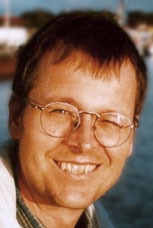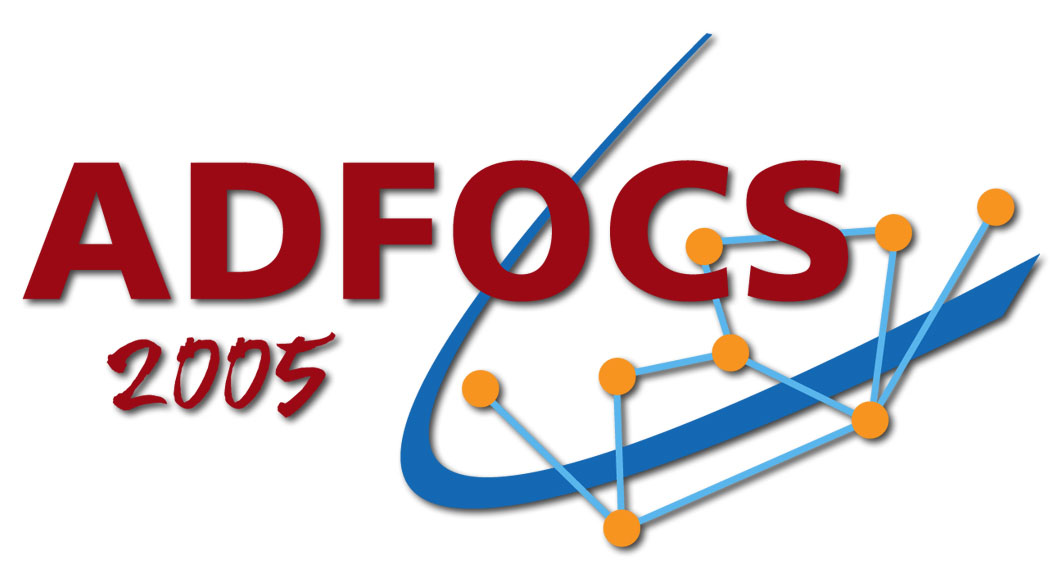|
Program
There will be eight blocks of lectures, exercises, and discussions,
two per lecturer. Each block is about 4 hours.
A morning or afternoon block will start with 1½ hours of
lecture, followed by 1½ hours of exercises (in small groups) with
coffee breaks, followed by a 1 hour discussion of the
exercises. During the exercise periods, the respective lecturer will
be around, as well as some fruit, snacks, and drinks.
Schedule
|
August 29
Monday |
August 30
Tuesday |
August 31
Wednesday |
September 1
Thursday |
September 2
Friday |
| 9.00-13.00 |
Erickson
Computing (with)
Curves on Surfaces I |
Erickson
Computing (with)
Curves on Surfaces II |
Rote
Pseudotriangulations I |
Zwick
Approximating
Distances in Graphs I |
Zwick
Approximating
Distances in Graphs II |
| 13.00-14.30 |
Lunch
break |
Lunch
break |
Lunch
break |
Lunch
break |
Lunch |
| 14.30-18.30 |
Klein
Dilation of Graphs
and Point Sets I |
Klein
Dilation of Graphs
and Point Sets II |
Excursion |
Rote
Pseudotriangulations II |
|
| Evening |
|
School Dinner |
|
|
|
Lecture(r)s
Below you find short abstracts and
accompanying literature of the
lectures. Clicking on the photos gets you to the respective
lecturer's homepage.
Jeff Erickson
University of Illinois at Urbana-Champaign
Computing (with) Curves on Surfaces
|
 |
This tutorial will be a short and biased introduction to
computational topology, focusing on algorithms that compute
and/or use shortest paths and cycles on topological
surfaces. For example, given a path around several obstacles in
the plane, how quickly can we find the shortest path that misses
the obstacles in exactly the same way? How quickly can we
detect if one path on the Stanford Bunny can be continuously
deformed into another? Given a surface, how quickly can we find
the shortest cycle that cannot be collapsed to a point, or the
shortest cycle that cuts the surface into two nontrivial pieces?
The tutorial will include an introduction to basic concepts from
topology, graph theory, and computational geometry; a survey of
algorithms for computing shortest paths in different topological
spaces; pointers to applications and more advanced results; and
several open problems.
For preparation have a look at
- Sergio Cabello, Yuanxin Liu, Andrea Mantler, and Jack Snoeyink,
"Testing homotopy for paths in the plane",
Discrete Comput. Geom. 31(1):61--81, 2004.
- Jeff Erickson and Sariel Har-Peled,
"Optimally cutting a surface into a disk",
Discrete Comput. Geom. 31(1):37-59, 2004.
- John Hershberger and Jack Snoeyink,
"Computing minimum length paths of a given homotopy class",
Comput. Geom. Theory Appl. 4(2):63--97, 1994.
Talk slides for download: Part 1 [pdf]
and Part 2 [pdf]
|
Rolf Klein
Universität Bonn
Dilation of Graphs and Point Sets
|
 |
One of the basic problems in network design
is the following. Given a set of points,
find a network connecting the points such that
the connecting paths are short and the cost of the
network is low.
This problem occurs in many variations. The network
may be required to be part of a given graph; we
may be allowed to use extra vertices; cost and
connectivity can be measured in different ways.
In this lecture we will focus on points in the plane
and on geometric networks N connecting them.
If p and q are points of N then the dilation
of p,q is defined as the ratio of the lenght
of a shortest path in N that connects p and q,
divided by their Euclidean distance.
The maximum of these values, taken over all pairs of
points from a certain subset S of N, is called the
dilation of N with respect to S.
Well-known is the case where S equals the set of all
vertices of N. Then the dilation of N is also called
its stretch factor or its spanning ratio. But
also the case where S consists of all points on N
vertices and interior edge points alike,
has received some recent interest under the name of
detour or geometric dilation.
We shall first discuss some classical results on geometric
spanners in the plane. Next, we will show how to efficiently
compute the dilation of a given network, for some simple
network structures. Then we turn to the following question.
Given a finite set of points, S, what is the smallest possible
dilation of a plane network that contains these points.
This number is defined as the dilation of S.
We present some results and many open questions.
For preparation have a look at D. Eppstein, "Spanning Trees and
Spanners", Handbook of Computational Geometry
|
Günter Rote
Freie Universität Berlin
Pseudotriangulations
|
 |
A pseudotriangulation is a decomposition of the plane into
pseudotriangles, polygons with exactly three convex vertices
and an arbitrary number of concave vertices. In the last years,
pseudotriangulations have emerged as a data structure
with a variety of applications: visibility complexes, ray shooting,
robot arm motion planning, kinetic collision detection,
guarding, reflex-free hulls, etc. I will survey some of the
algorithmic, geometric and combinatorial properties of
pseudotriangulations, as well as their connections to rigidity,
convexity, and polytope theory.
For preparation have a look at
- GŁnter Rote, Francisco Santos, and Ileana Streinu,
"Expansive motions and the polytope of pointed
pseudo-triangulations",
Discrete and Computational Geometry - The
Goodman-Pollack Festschrift. Editors: Boris Aronov,
Saugata Basu, JŠnos Pach, and Micha Sharir, Algorithms
and Combinatorics, 25, Springer Verlag, Berlin, 2003,
pp. 699-736, arXiv:math.CO/0206027.
http://arxiv.org/abs/math.CO/0206027
http://page.mi.fu-berlin.de/~rote/Papers/abstract/
Expansive+motions+and+the+polytope+of+pointed+pseudo-triangulations.html
- Ruth Haas, David Orden, GŁnter Rote, Francisco Santos,
Brigitte Servatius, Herman Servatius, Diane Souvaine, Ileana
Streinu, and Walter Whiteley
"Planar minimally rigid graphs and pseudo-triangulations",
Computational Geometry, Theory and Applications 31
(2005), 31-61, arXiv:math.CO/0307347.
http://arxiv.org/abs/math.CO/0307347
http://page.mi.fu-berlin.de/~rote/Papers/abstract/
Planar+minimally+rigid+graphs+and+pseudo-triangulations.html
- David Orden, GŁnter Rote, Francisco Santos, Brigitte
Servatius, Herman Servatius, and Walter Whiteley,
"Non-crossing frameworks with non-crossing reciprocals",
Discrete and Computational Geometry 32 (2004), 567-600,
(Special issue in honor of Lou Billera),
arXiv:math.MG/0309156
http://arxiv.org/abs/math.MG/0309156.
http://page.mi.fu-berlin.de/~rote/Papers/abstract/
Non-crossing+frameworks+with+non-crossing+reciprocals.html
.
Talk slides for download: [pdf]
Also available from Günter Rote's page.
|
Uri Zwick
Tel Aviv University
Approximating Distances in Graphs
|
 |
Computing distances and shortest paths is one of the most basic
algorithmic graph problems. Classical algorithms can be used to
find all the distances in a graph with n vertices and m edges in
about O(mn) time and O(n²)
space. When the graph is very large these time and space bounds
may be prohibitive. Can fewer resources be used if only
approximate distance are required?
We present more efficient algorithms for computing approximate
distances in undirected graphs. For unweighted graphs we get
approximations with small additive error. For weighted graphs,
with non-negative edge weights we get approximations with small
multiplicative error.
We next consider the problem of finding sparse graphs, called
spanners, that approximate well all the distances in the
original graph. We obtain a tight trade off between the size of a
spanner and its stretch and present efficient algorithms for
finding good spanners.
We end with the construction of approximate distance
oracles. These are algorithms for preprocessing a given input
graph, using much less than O(mn) time and
O(n²) space, such that each distance query can
then be answered, approximately, in constant time.
For preparation have a look at
- Dorit Dor, Shay Halperin, Uri Zwick,
"All Pairs Almost Shortest Paths",
SIAM Journal on Computing 29, 1740-1759 (2000).
- Surender Baswana, Sandeep Sen,
"A Simple Linear time Algorithm for Computing
(2k-1)-spanner of O(n^{1+1/k}) size for
weighted graphs",
Proc. of ICALP'03, pp. 384-296.
- Mikkel Thorup, Uri Zwick,
"Approximate Distance Oracles",
Journal of the ACM, 52, 1-24 (2005).
Draft and links to the first and the third paper are available
from
Uri Zwick's homepage . A draft of the Baswana-Sen paper is
available on Surender Baswana's web page.
Talk slides for download: [pdf]
|
Organization
ADFOCS 2005 is organized by Martin Kutz & Nicola Wolpert.
Help with local arrangements:
Petra Mayer.
For comments or questions send an email to
adfocs[at]mpi[minus]inf[dot]mpg[dot]de.
|
|



